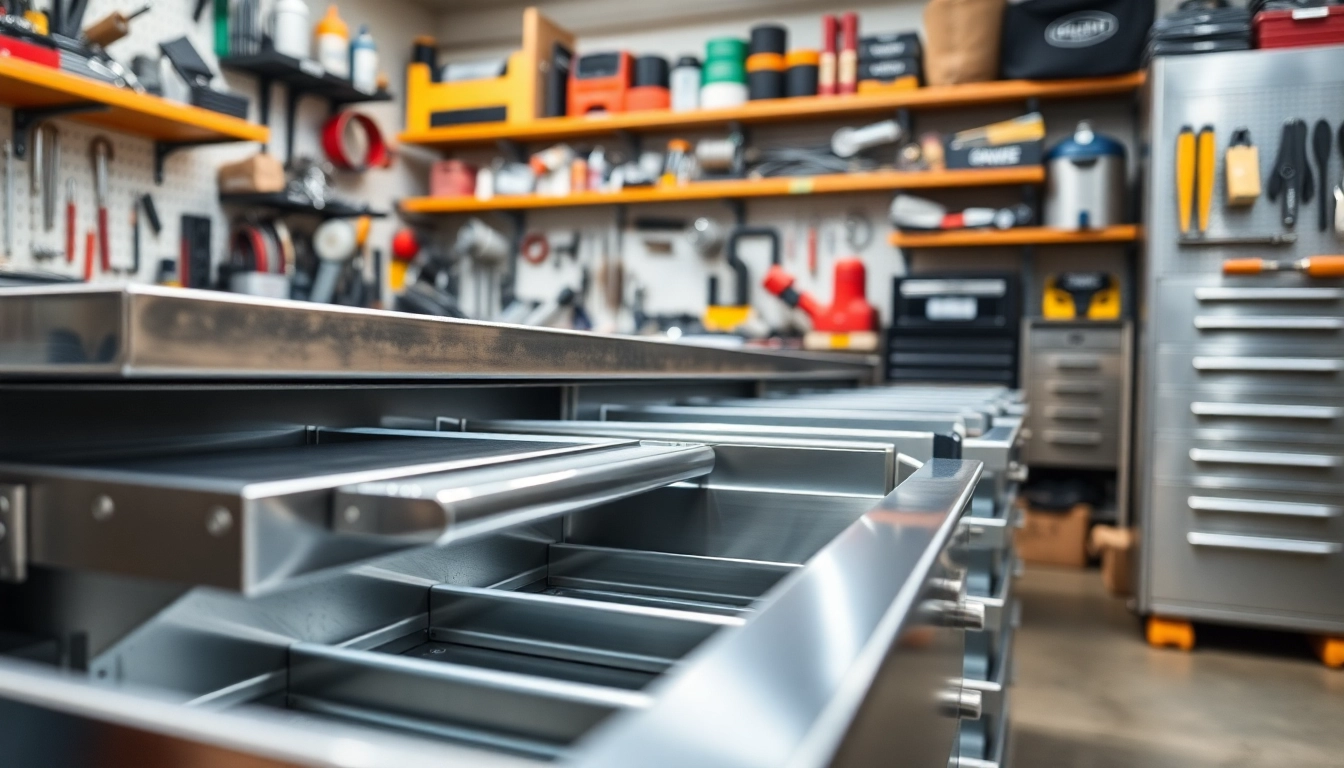Understanding Metal Drawer Systems
Metal drawer systems have gained significant popularity in modern cabinetry and furniture construction due to their durability, functionality, and aesthetic appeal. Families, businesses, and industrial settings have all enhanced their storage solutions with this versatile technology. Indeed, a Metal Drawer System offers not only efficiency but also a variety of stylistic options to suit any environment.
What is a Metal Drawer System?
A metal drawer system comprises structured metal components designed to form drawers within cabinets, dressers, and other furniture units. Unlike wooden drawer systems, metal systems boast enhanced resilience against humid conditions, warping, and mechanical failure. Generally, these systems include a box-style frame made from steel or aluminum and are complemented by drawer slides, glides, and other hardware that facilitate smooth operation and functionality.
Key Components of Metal Drawer Systems
Understanding the components of a metal drawer system is essential for those looking to install or utilize such solutions. Here are the primary parts involved:
- Drawer Box: The main structure that holds items, typically constructed from cold-rolled steel or aluminum, providing both strength and durability.
- Drawer Slides: The mechanisms that allow the drawer to slide in and out of its cavity smoothly. These can be side-mounted, under-mounted, or even concealed.
- Front and Back Panels: These components manage the drawer’s height and width, lending it stability and preventing warping.
- Hardware and Accessories: These may include handles, locks, and soft-close mechanisms that improve functionality and user experience.
Types of Metal Drawer Systems Available
Metal drawer systems come in various configurations and designs to meet different usage requirements. Some popular types include:
- Heavy-Duty Drawer Systems: Designed for industrial applications, capable of holding heavier weights and subject to rigorous use.
- Concealed Drawer Systems: These systems hide the slides, presenting a cleaner aesthetic suitable for modern designs.
- Ball-Bearing Drawer Slides: These provide smooth operation, often used in residential furniture and office equipment.
- Modular Drawer Systems: Flexible units available in various sizes, enabling customization for specific spaces or storage needs.
Advantages of Metal Drawer Systems
Choosing a metal drawer system comes with numerous benefits that elevate storage capabilities. From durability to design flexibility, here’s an in-depth look at the advantages.
Durability and Strength of Metal Drawer Systems
One of the most notable advantages of metal drawer systems is their exceptional durability. Constructed from high-quality metals, these systems can withstand significant amounts of weight and stress without bending or breaking. Compared to wooden systems, metal drawers are less susceptible to dents, scratches, and moisture-related damage, ensuring long-term use even in challenging environments.
Design Flexibility and Customization Options
Metal drawer systems offer extensive design flexibility, from dimensions and layouts to colors and finishes. They can be integrated into various furniture designs, accommodating different styles—from industrial chic to sleek modern interiors. Additional customization options include unique hardware selections and finish treatments that can match or contrast with existing décor.
Cost-Effectiveness Over Time
While the initial investment in metal drawer systems may be higher than wooden counterparts, the long-term savings are noteworthy. Due to their durability, these systems typically require less maintenance and replacement, translating to lower overall costs in the long run. Furthermore, metal materials can sustain wear and tear better than wood, thus contributing to reduced repair expenses.
Best Practices for Installation and Usage
Installing and using metal drawer systems can be straightforward, but following best practices ensures optimal performance. Let’s examine some essential steps in this process.
Preparing for Installation of Metal Drawer Systems
Before installation, performing the necessary preparations can save time and prevent issues. Consider the following steps:
- Measurements: Ensure the intended space is accurately measured to accommodate the size of the drawer system.
- Gather Tools: Common tools for installation include a drill, screwdriver, a level, and measuring tape.
- Review Instructions: Familiarize yourself with the product’s manual for specific instructions and recommendations on the installation process.
Common Installation Mistakes to Avoid
Even minor mistakes can lead to functional issues with metal drawer systems. To ensure a successful installation:
- Neglecting to Level: Always check that the drawer rails are level. An unleveled installation may cause jamming during use.
- Over-tightening Screws: Excessive tightening can warp the drawer components, leading to problems with sliding.
- Ignoring Weight Limits: Each system has weight restrictions—disregarding these can cause the mechanism to fail.
Maintenance Tips for Longevity
To prolong the life of metal drawer systems, routine maintenance is essential:
- Regular Cleaning: Dust and debris can hinder the smooth operation; cleaning the sliders and tracks can prevent this.
- Lubrication: Applying lubricant to moving parts can ensure smooth operation and reduced friction.
- Inspect Hardware: Periodically check for loose screws or damage, tightening or replacing as necessary.
Comparing Metal Drawer Systems to Alternatives
Comparing metal drawer systems to other options available in the market reveals their unique advantages tailored to specific requirements.
Wooden vs. Metal Drawer Systems: Pros and Cons
The age-old battle between wooden and metal drawer systems continues. Let’s explore the strengths and weaknesses of both:
| Feature | Wooden Drawer Systems | Metal Drawer Systems |
|---|---|---|
| Durability | Moderate | High |
| Moisture Resistance | Low | High |
| Weight Capacity | Moderate | High |
| Design Versatility | High | Moderate |
Why Choose Metal Drawer Systems for Industrial Use?
Given their robust construction, metal drawer systems are well-suited for industrial applications. Their resistance to heavy wear, environmental factors, and shifting loads makes them an ideal choice for factories, warehouses, and other demanding settings. Furthermore, their high weight capacity can accommodate tools, equipment, and other heavy items without risk of failure.
Performance Metrics: What to Look For
When evaluating metal drawer systems, consider the following metrics to ensure optimal performance:
- Weight Limit: Understand the maximum load capacity to align usage expectations.
- Slide Quality: Assess the type of slides or slides used to determine functionality and longevity.
- Warranty: Manufacturers should provide a warranty indicating confidence in product quality.
Innovative Trends in Metal Drawer Systems
The manufacturing and design of metal drawer systems continue to evolve, introducing technologies and materials that enhance their function and appeal.
Emerging Technologies in Drawer Engineering
Advancements in technology have led to innovative manufacturing techniques in metal drawer systems. Some notable developments include:
- Smart Technology Integration: Some systems now feature IoT capabilities, allowing for tracking and monitoring of inventory within drawers.
- 3D Printing: Customizable components can now be made quickly using additive manufacturing, reducing lead times and costs.
- Self-Closing Mechanisms: Advanced designs automatically close gently, offering smoother and quieter usage.
Eco-Friendly Materials for Metal Drawer Systems
Environmental concerns have pushed manufacturers to lean towards sustainable practices. Eco-friendly materials, including recyclable metals and reduced waste processes, are becoming more commonplace. Additionally, energy-efficient production methods are gaining traction, ensuring a smaller carbon footprint associated with these systems.
Future of Metal Drawer Design and Functionality
The future of metal drawer systems looks promising, with continuous innovations poised to enhance design and functionality. As consumer preferences shift towards sustainable and efficient solutions, manufacturers are likely to pursue greater customization, improved materials, and integration with smart home technologies. This will make metal drawer systems even more attractive for both residential and commercial users.




